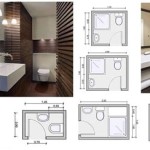Replacing a Bathroom Sink and Vanity: A Comprehensive Guide
Replacing a bathroom sink and vanity can significantly enhance the aesthetics and functionality of a bathroom. The process, while manageable for experienced DIY enthusiasts, requires careful planning, proper tools, and a thorough understanding of plumbing and electrical systems. This guide provides a detailed walkthrough of replacing a bathroom sink and vanity, ensuring a successful and professional-looking outcome.
Before commencing any work, it is crucial to prioritize safety. This involves turning off the water supply to the bathroom and disconnecting any electrical components associated with the vanity, such as lighting fixtures or outlets. Failure to do so can result in property damage, serious injury, or even death.
1. Preparation and Planning
The initial stage involves meticulous planning and preparation. This includes selecting the appropriate replacement sink and vanity, gathering necessary tools and materials, and carefully assessing the existing plumbing and electrical configurations.
Selecting the Replacement: The first step is choosing a new sink and vanity that meets aesthetic preferences, functional requirements, and spatial constraints. Consider factors such as the size of the bathroom, the desired style (e.g., modern, traditional, minimalist), the type of sink (e.g., undermount, vessel, drop-in), and the amount of storage space needed. Ensure the new vanity's dimensions are compatible with the existing plumbing and electrical connections. Measure the available space accurately, paying attention to the placement of water supply lines, drainpipes, and any wall obstructions.
Gathering Tools and Materials: A comprehensive toolkit is essential for a smooth replacement process. Required tools typically include:
*Adjustable wrench: For disconnecting and tightening plumbing connections.
*Basin wrench: Specifically designed for reaching and loosening hard-to-access faucet nuts.
*Pipe wrench: For gripping and turning pipes.
*Pliers: For various gripping and cutting tasks.
*Screwdrivers (Phillips and flathead): For removing and installing screws.
*Utility knife: For cutting caulk and other materials.
*Level: For ensuring the vanity is installed straight and level.
*Stud finder: For locating wall studs to securely mount the vanity.
*Drill with various drill bits: For drilling pilot holes and securing screws.
*Caulk gun: For applying sealant to prevent water leaks.
*Measuring tape: For accurate measurements.
*Safety glasses: To protect eyes from debris.
*Gloves: To protect hands.
*Bucket: To catch water during plumbing disconnections.
*Towels or rags: For cleaning up spills.
In addition to tools, essential materials include:
*Plumber's putty: For sealing sink drains.
*Teflon tape: For sealing threaded pipe connections.
*Caulk (silicone or acrylic): For sealing around the sink and vanity.
*Supply lines (if needed): To connect the water supply to the faucet.
*P-trap (if needed): To prevent sewer gases from entering the bathroom.
*Drain extension (if needed): To adjust the drainpipe length.
*Fasteners (screws, anchors): To secure the vanity to the wall.
Assessing Existing Plumbing and Electrical: Before removing the old vanity, carefully inspect the existing plumbing and electrical connections. Note the location of water supply lines, drainpipes, and any electrical wiring. Take photographs for reference. This assessment will help determine if any modifications or adjustments are needed during the installation process. Check the condition of the shut-off valves for the water supply. If they are corroded or damaged, consider replacing them to ensure a reliable water shut-off.
2. Removal of the Existing Vanity and Sink
The removal process requires a systematic approach to avoid damage to surrounding surfaces and ensure a clean and safe workspace.
Shutting Off Water and Disconnecting Plumbing: The most critical step is turning off the water supply to the bathroom sink. Locate the shut-off valves under the sink and turn them clockwise until fully closed. If shut-off valves are not present, the main water supply to the house must be turned off. Once the water is off, place a bucket under the sink and disconnect the water supply lines from the faucet. Use an adjustable wrench to loosen the connections. Be prepared for some residual water to drain out. Next, disconnect the drainpipe from the sink drain. This usually involves loosening a slip nut. Again, have a bucket ready to catch any water. Remove the P-trap and drain extension if necessary.
Disconnecting Electrical Components: If the vanity has electrical components, such as lighting fixtures or outlets, disconnect the power supply to the circuit breaker. Use a voltage tester to confirm that the power is off before proceeding. Carefully disconnect the wiring, taking note of the wire connections (e.g., black to black, white to white, ground to ground). Use wire connectors to safely cap off the exposed wires.
Removing the Old Vanity: Once the plumbing and electrical connections are disconnected, the old vanity can be removed. Depending on how the vanity is attached, it may be necessary to loosen screws, bolts, or adhesive. Use a stud finder to locate the wall studs behind the vanity. Remove any screws or bolts that are anchoring the vanity to the studs. If the vanity is caulked to the wall, use a utility knife to carefully cut along the caulk line. With assistance, carefully lift and remove the old vanity from the bathroom. Be mindful of its weight and avoid damaging the surrounding walls or flooring.
Preparing the Installation Area: After removing the old vanity, thoroughly clean the installation area. Remove any debris, old caulk, or adhesive residue. Inspect the wall for any damage and make necessary repairs. If the wall is uneven, use shims to create a level surface for the new vanity. Consider touching up the paint on the wall to freshen up the space.
3. Installation of the New Vanity and Sink
The installation process involves carefully positioning the new vanity, connecting the plumbing and electrical components, and ensuring a secure and leak-free installation.
Positioning the Vanity: Carefully position the new vanity in the designated location. Use a level to ensure that it is perfectly level. If necessary, use shims under the base of the vanity to achieve a level surface. Once the vanity is level, mark the location of the wall studs on the back of the vanity. Drill pilot holes through the vanity frame into the studs. Secure the vanity to the wall using screws or bolts. Ensure that the fasteners are long enough to penetrate the studs securely. Consider using wall anchors for added support, especially if the vanity is heavy or if the studs are not ideally located.
Installing the Sink and Faucet: Install the sink into the vanity according to the manufacturer's instructions. Depending on the type of sink, this may involve applying plumber's putty around the drain opening and securing the sink with clips or mounting brackets. Install the faucet into the sink according to the manufacturer's instructions. Connect the water supply lines to the faucet. Use Teflon tape on the threaded connections to prevent leaks. Tighten the connections with an adjustable wrench. Be careful not to overtighten, as this can damage the fittings.
Connecting the Plumbing: Connect the drainpipe to the sink drain. Install the P-trap and drain extension if necessary. Ensure that all connections are tight and secure. Use plumber's putty or Teflon tape on the threaded connections to prevent leaks. After connecting the plumbing, turn on the water supply and check for leaks. Inspect all connections carefully. If any leaks are detected, tighten the connections or replace the fittings as needed.
Connecting the Electrical Components: If the vanity has electrical components, connect the wiring according to the previous connections. Ensure that the power supply to the circuit breaker is turned off before proceeding. Use wire connectors to safely connect the wires (e.g., black to black, white to white, ground to ground). Secure the wiring inside the vanity cabinet. Turn on the power supply to the circuit breaker and test the electrical components to ensure they are functioning properly.
Sealing and Finishing: Apply caulk around the sink and vanity to seal any gaps and prevent water leaks. Use a caulk gun to apply a bead of caulk along the edges of the sink and vanity where they meet the wall or countertop. Smooth the caulk with a wet finger or a caulk smoothing tool. Allow the caulk to dry completely before using the sink. Install any additional hardware or accessories, such as cabinet pulls or towel bars. Clean up the installation area and dispose of any waste materials.
Replacing a bathroom sink and vanity is a project that can significantly improve the look and feel of a bathroom. By following these steps carefully, even a novice DIYer can achieve a professional-looking result. However, if any part of the process feels overwhelming or exceeds existing skill levels, engaging a qualified plumber or contractor is the most prudent course of action.

How To Install A Bathroom Vanity And Sink

How To Install A Bathroom Vanity

How To Remove A Bathroom Vanity Budget Dumpster



12 Easy Steps To Install Bathroom Vanity And Sink

How To Remove Replace A Vanity Top Easy Bathroom Sink Remodel

Who Installs Bathrooms Vanities And Sinks

How To Replace A Bathroom Countertop Homeadvisor

How To Install Or Remove A Bathroom Vanity Homeserve Usa







